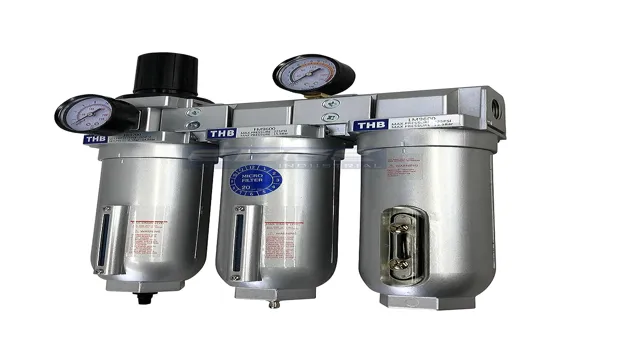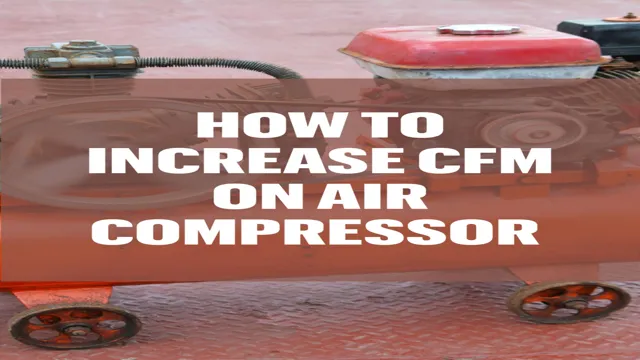
Are you tired of experiencing rust or corrosion in your pneumatic tools and equipment due to excess moisture in your air compressor? Worry no more! Removing moisture from an air compressor isn’t rocket science, and you do not need to hire an expert to help you out. The build-up of moisture in your compressor tank is quite common, especially if you regularly use it in areas with high humidity levels. You see, when air gets compressed, humidity levels rise, causing moisture to accumulate in the tank.
This moisture can cause serious damage to your equipment, and that’s why removing it from your compressor should be a top priority. But how do you do it efficiently without causing further damage to your machine? Keep reading for some pro tips!
Understanding the problem
Moisture in an air compressor can cause a lot of problems. It can lead to rusting of the internal parts of the compressor, which can impact its performance. The most common way to get rid of moisture from the air compressor is by using a compressor dryer.
A compressor dryer is a device that reduces the moisture content in the compressed air by removing the water vapor. Another way is to drain the moisture regularly. This can be done by opening the drain valves located at the bottom of the compressor.
The water that gets collected in the bottom can be drained out using these valves. It is recommended to drain the moisture out of the compressor after every use to avoid any rusting or damage to the internal parts. Overall, keeping the compressor dry is important to ensure its longevity and performance, and with these simple steps, you can achieve it easily.
What causes moisture in an air compressor?
Moisture in an air compressor can cause a myriad of problems. It can ruin finished products, corrode equipment, and even lead to health hazards. Understanding the root cause of moisture in an air compressor is key to addressing the issue.
Generally, moisture comes from humid air drawn into the compressor. As the air is compressed, the temperature of the air increases and causes water vapor to condense. If the compressor is not adequately equipped with moisture-removal devices, the water can build up and cause major problems.
The solution to this problem is to invest in appropriate moisture-removal devices, such as a refrigerated air dryer or desiccant air dryer. This will help eliminate water buildup and ensure the compressor runs smoothly. Remember, addressing moisture in an air compressor is crucial to maintaining efficient, effective operations.

Why is it necessary to remove moisture from an air compressor?
Air compressor moisture removal When it comes to air compressors, moisture can be a significant issue. This condensation can build up inside the compressor tank and damage the unit, causing corrosion and rust. It can also lead to reduced efficiency and increase the likelihood of breakdowns or malfunctions.
Moisture can even cause damage to the tools or equipment that the compressor powers. That’s why it’s necessary to remove moisture from the air compressor. Moisture can be effectively removed through the use of an air compressor dryer, which filters the compressed air through a membrane or sieve that absorbs the moisture and traps it inside.
This simple process ensures that your compressor stays in top working order and lasts as long as possible. By removing moisture, you can prevent costly repairs, keep your tools running smoothly, and ensure that your compressor operates efficiently. So, if you want to extend the lifespan of your air compressor, remove moisture regularly with an air dryer.
Methods for removing moisture
If you’re using an air compressor, it’s important to know how to get moisture out of it. This is because moisture in the compressor can lead to rust, corrosion, and other issues that can damage the compressor over time. There are several methods you can use to remove moisture from your compressor, including drain valves, moisture separators, and desiccant dryers.
Drain valves are the most basic method and simply involve opening a valve to let the moisture escape. Moisture separators use filters to trap moisture and prevent it from entering downstream equipment. Desiccant dryers, on the other hand, use a substance called desiccant to absorb moisture from the air.
By regularly using these methods, you can prevent moisture from damaging your air compressor and ensure that it continues to work effectively for years to come.
Draining the air compressor
If you want to keep your air compressor in top condition, it’s important to drain it regularly to remove any water or moisture that has built up. Moisture can accumulate in the tank and cause corrosion, reduce the lifespan of your tools, and affect the quality of your work. There are a few different methods for removing moisture from your air compressor.
One common method is to open the drain valve at the bottom of the tank and let the moisture drain out. Another option is to install a moisture trap or filter in the air compressor’s hose to catch any excess moisture before it reaches your tools. Whichever method you choose, it’s important to do it regularly to prevent any damage and ensure your air compressor lasts for years to come.
Using an air dryer
If you’re looking for ways to remove moisture from your hair, using an air dryer is a fantastic option. Not only does it save a lot of time, but it’s also gentle on your hair. There are different ways you can use a hair dryer to get rid of moisture.
First, you can use the lowest heat setting and dry your hair in sections. This ensures that every part of your hair is dried evenly. Second, you can use a diffuser attachment to concentrate airflow and dry your hair without causing damage.
Lastly, you can use a cold shot button on your hair dryer to seal the cuticles and prevent frizz. By using any of these methods, you can enjoy a frizz-free and polished hair look.
Installing a water trap
When it comes to installing a water trap, there are several methods for removing moisture that can be utilized. One common approach involves using a desiccant, which is a substance that absorbs water from the air. These can come in the form of silica gel packets or reusable moisture absorbers.
Another option is to use a dehumidifier, which draws moisture from the air and collects it in a container. These can be particularly useful in damp or humid environments. Additionally, it’s important to ensure that any sources of water, such as leaks or standing water, are addressed and fixed to prevent further moisture buildup.
By utilizing these methods and taking preventative measures, you can effectively remove moisture from your space and avoid potential damage caused by excess water.
Using a coalescing filter
Using a coalescing filter is one of the most effective methods for removing moisture from compressed air systems. This filtration method works by making water droplets in the air flow stick together, forming larger droplets that can be more easily separated and removed from the system. The coalescing filter is specifically designed to capture these larger droplets, preventing them from re-entering the air flow and causing damage to downstream equipment.
This is accomplished using a series of filters with progressively smaller pores, which trap the water droplets and allow only dry air to pass through. By regularly replacing these filters, users can ensure that their compressed air system remains free of moisture and operates at its highest efficiency.
Preventive measures
If you’re wondering how to get moisture out of your air compressor, there are a few preventive measures you can take to avoid the build-up of moisture in the first place. First, make sure your compressor is located in a well-ventilated area, away from moisture-prone areas such as damp basements or near water sources. Additionally, you can install a moisture filter to your air compressor to catch any excess moisture before it enters the air supply.
Regularly draining the air tanks and changing the oil can also help prevent moisture build-up. If you do notice moisture in your air compressor, it’s important to drain it and use a moisture-absorbing agent such as silica gel to help dry out the air. By taking these preventive measures, you can ensure that your air compressor runs smoothly and efficiently for years to come.
Regular maintenance
Regular maintenance is an essential aspect of ensuring the longevity and efficiency of any machine or appliance. When it comes to vehicles, preventive measures such as regular oil changes, tire rotation, and tune-ups can prevent major problems from occurring down the line. Neglecting routine maintenance can lead to costly repairs and even endanger the lives of those on the road.
Regular inspection of belts, hoses, and transmission fluid can help avoid unnecessary breakdowns and inconveniences. It’s the little things that often go unnoticed that can lead to big problems. By staying up-to-date with regular maintenance, car owners can save themselves time, money, and hassle in the long run.
So, take care of your car, and it will take care of you, ensuring that you arrive at your destination safely and on time.
Proper storage and usage
When it comes to proper storage and usage of certain items, it’s important to take preventive measures to avoid any potential accidents. For example, if you’re storing chemicals, make sure they are labeled correctly and kept out of reach of children or pets. If you’re using power tools, always wear the appropriate safety gear such as goggles or gloves.
In addition, make sure to properly maintain and store your tools to prevent rust or mechanical failure. When it comes to firearms, always keep them unloaded and stored in a safe place away from unauthorized users. By taking these preventive measures, you can ensure that you and those around you stay safe while using and storing potentially dangerous items.
Conclusion
In short, getting moisture out of your air compressor is like a game of catch and release – the water comes in, but you don’t want it to stay. With a combination of proper maintenance, good installation practices, and a few clever hacks, you can keep your compressor running dry and ensure crisp, clean air for all your pneumatic adventures. So go forth and conquer your compressors, dear airheads – no more soggy tools or rusty pipes in your future!”
FAQs
What causes moisture in air compressors?
Moisture in air compressors is caused by high humidity levels in the surrounding air. When the air is compressed, the moisture condenses and collects in the tank.
What problems can moisture cause in an air compressor?
Moisture in an air compressor can cause rust and corrosion, decrease the efficiency of the compressor, damage tools and equipment, and contaminate the air.
How can I tell if there is moisture in my air compressor?
One way to tell if there is moisture in your air compressor is to check for water in the tank or air lines. You can also test the air pressure by releasing some air into a clean, dry cloth. If the cloth becomes damp, there is moisture present.
What are some ways to prevent moisture from accumulating in an air compressor?
To prevent moisture from accumulating in an air compressor, you can install a moisture filter, drain the tank regularly, keep the compressor in a dry environment, and avoid using the compressor in humid conditions.
How often should I drain the tank of my air compressor to remove moisture?
The frequency of draining the tank of an air compressor will depend on the amount of use it gets, the humidity levels in the air, and the type of compressor. As a general rule, it is recommended to drain the tank after every use or at least once a week.
Can I use a hair dryer to dry out my air compressor?
No, you should not use a hair dryer to dry out your air compressor. This can cause the temperature inside the compressor to rise too quickly and damage the components. Instead, use a moisture filter or drain the tank.
Is it necessary to use a moisture filter with an air compressor?
It is not always necessary to use a moisture filter with an air compressor, but it is highly recommended to prevent moisture from accumulating in the tank and air lines. This can help to prolong the life of the compressor and prevent damage to tools and equipment.







